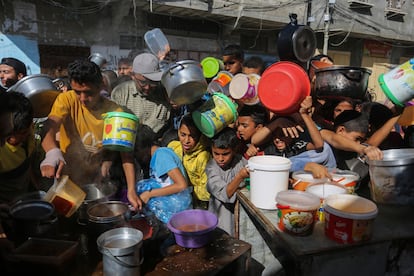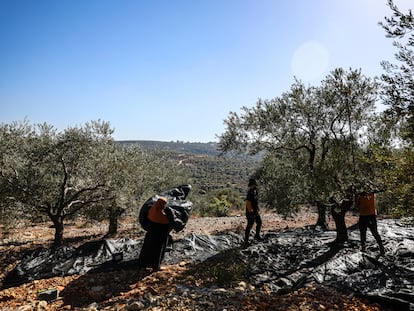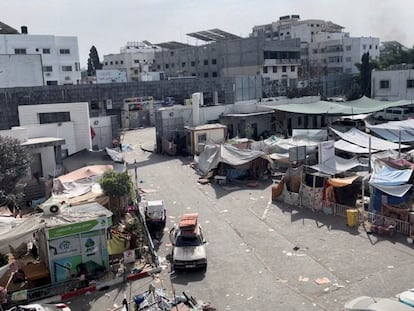UN warns that Gaza’s population will begin to starve if fuel does not arrive
The entry of food through Egypt is stopped due to the lack of fuel for the vehicles that distribute it to the refugees. Gaza’s death toll has risen to 12,000, including 5,000 children, according to authorities in the Strip


Some Gazans have been saved from starvation and total abandonment partially thanks to the meager humanitarian aid entering through the Rafah crossing, on the border with Egypt. But this flow of supplies has stopped again, the U.N. agency for Palestinian refugees (UNRWA) confirmed Friday. With no fuel for the vehicles distributing the food, and with communications cut off since Thursday for the same reason, the U.N. agency has admitted it is powerlessness to deliver supplies that, in any case, were only enough to feed 7% of the Strip’s 2.3 million inhabitants. Without that food, even those who survive the relentless bombardment and the Israeli ground invasion could have their days numbered, warned UNRWA Commissioner General Philippe Lazzarini.
“If the fuel does not come in, people will start to die because of the lack of fuel. Exactly as from when, I don’t know. But it will be sooner rather than later,” he said. The day before, the U.N. World Food Program (WFP) had warned in a statement of exactly the same thing: “The Strip now faces a massive food gap and widespread hunger, as nearly the entire population is in desperate need of food assistance.”
Earlier this week, the last WFP bakery in the Strip had to close its doors for lack of electricity and fuel to generate it. Bread is the basis of the Gazan diet, which even before the war was seriously inadequate, mainly because of the blockade imposed by Israel over the past 16 years after the fundamentalist Hamas movement came to power in 2007. With the closure of the last of the 130 such establishments with which the United Nations collaborated, this staple food is “scarce or non-existent” in Gaza. In the Palestinian territory now under a total blockade since October 7, when Hamas attacked Israel, those who are lucky eat canned food or something else; those who aren’t, “raw onions or eggplants,” the U.N. agency warned.
“The trucks arrive very, very occasionally and the conditions are extremely harsh,” Alaa Hamuda confirms to EL PAÍS from the Khan Yunis refugee camp. This Palestinian academic, who barely manages to answer a few questions in the minutes in which the internet connection is momentarily restored, is originally from Beit Lahia, in the north of the Palestinian enclave. He is now a refugee in a UNRWA center, the Khan Younis Training Center, the most overcrowded of all, which at the beginning of November held more than 22,000 displaced people.
No medicine or food
Professor Hamuda explains that in the south of the strip the fundamental problem, “is [the lack of] water.” He goes on to describe how the situation north of the dried-up Gaza River, the area Israel ordered evacuated, is much worse: “There is famine there. There is no medicine, no food of any kind. Humanitarian aid is not coming at all. Any truck crossing the Gaza [river] valley can be bombed.” After this response, the connection is cut again.
“With winter fast approaching, unsafe and overcrowded shelters, and the lack of clean water, civilians are facing the immediate possibility of starvation,” said WFP Executive Director Cindy McCain in the organization’s statement. “There is no way to meet current hunger needs with one operational border crossing. The only hope is opening another, safe passage for humanitarian access to bring life-saving food into Gaza,” she added, alluding to the rest of the crossings that separate the Strip from the territory of Israel, all closed since October 7.
On November 10, the Gaza Ministry of Health announced that it would stop counting the daily deaths due to the impossibility of knowing how many more Gazans had perished each day due to bombing or in the Israeli ground offensive; how many had been buried under the rubble; and how many had been injured. The latest update came this Friday: more than 12,000 dead, including 5,000 children. And also this Friday, the Palestinian Wafa news agency, cited by Reuters, reported an Israeli attack in which several displaced Palestinians died — nine, according to Al Jazeera — precisely next to the Rafah border crossing.
In the face of successive warnings of the risk of starvation facing the Gazans, a government source quoted by the Israeli newspaper Haaretz has assured that Israel’s War Cabinet has given in to a request from the United States: to allow the entry of two trucks of fuel a day into Gaza, provided that they are certain that this fuel — 120,000 liters every 48 hours — does not end up in the hands of Hamas. Earlier this week, UNRWA had raised the amount needed in the Palestinian enclave for basic humanitarian operations such as food distribution to 160,000 liters per day.
In fact, this Friday is the third consecutive day that no aid trucks have entered Gaza, according to the United Nations Office for the Coordination of Humanitarian Affairs (OCHA). The last ones that did, on Tuesday, through the Rafah crossing — the only one not fully controlled by Israel — could merely be unloaded. UNRWA no longer had the fuel to deliver its contents to the civilian refugees housed in its 154 facilities: 813,000 of the approximately 1.5 million Gazans displaced by the war. In addition to hunger, there is also thirst, as Hamuda points out. Videos posted on social media in recent days show Gazan children collecting water for drinking from the first autumn rains in buckets.
Since October 21, when Israel accepted the entry of the first vehicles carrying basic necessities — two weeks after launching the war in response to the Hamas attack in which 1,200 people were killed and 240 others kidnapped — 1,129 trucks have entered the Palestinian territory. Of these, only 447 were carrying food, WFP regrets. Before the war, an average of 500 such vehicles entered the Strip every day.
Malnutrition, lack of water and hygiene have already led to numerous cases of infectious diseases, warned Richard Peeperkorn, WHO representative in the occupied Palestinian territories. He reported 70,000 cases of acute respiratory infections and more than 44,000 cases of diarrhea. Both pathologies particularly affect children under five years of age. More than 300,000 Gazan children have not yet reached that age, according to OCHA data.
The “next phase”
Starvation remains, however, not the most immediate threat to the 2.3 million people crammed into Gaza’s little more than 365 square kilometers, mostly in the south of the territory. Both in the north and in the south, where many Gazans fled in search of safety, Israeli shelling continues unabated. The ground offensive of its army is not stopping either. Israeli Defense Minister Yoav Gallant announced Thursday that his forces had completed the seizure of western Gaza City and were beginning “the next phase” of their ground operation.
Like the actual death toll, the fate of the health workers, patients and displaced persons who still remain in the Al Shifa hospital in Gaza City is unknown. On Wednesday, Israeli forces attacked the largest hospital in the Palestinian enclave, including with heavy artillery. They had been claiming for weeks that the hospital is hiding Hamas’ headquarters in its basement. This Friday, the military authorities released a video showing a hole in the ground of the hospital’s facilities. They claim that it is the entrance to one of the fundamentalist organization’s tunnels.
The Israeli army, which forbids national and international media to report from Gaza, has allowed some journalists — such as a correspondent from The New York Times — to enter the Strip with a military unit. However, none of these journalists have reported conclusive evidence that Al Shifa is anything other than a hospital. The rules at the heart of international humanitarian law — the Geneva Conventions of 1949 and their additional protocols of 1997 — grant enhanced protection to hospitals and make it a war crime to attack them.
The Israeli army also reported on Friday the discovery of the body of 19-year-old soldier Noa Marciano, kidnapped by Hamas on October 7, in a building near Al Shifa. The day before, its troops had recovered, allegedly also near the hospital, the body of another Israeli hostage, Yehudit Weiss, 65 years old. The Israel Defense Forces have also claimed to have destroyed key Islamic Jihad facilities and claim to have found bombs and weapons hidden in children’s schools in Gaza.
Al Shifa was not the only Palestinian hospital to be surrounded: also Ibn Sina, the main health center in Jenin, a city in the north of the occupied West Bank. The siege, which ended after several hours, came after five Palestinians were shot dead by drone fire in the city’s refugee camp, according to Al Jazeera. Israel claims the men were “Hamas terrorists” and that they surrounded the Jenin hospital because other fundamentalists had used it for hiding.
In another West Bank city, Hebron, in the south, two other men were killed by military gunfire. The Israeli version is that they had opened fire on the soldiers, who then responded. The Palestinian Ministry of Health reduces to three the number of dead in Jenin and raises the number of wounded to 15, four of them in serious condition. Since October 7, the Israeli army has killed some 200 people in attacks in the West Bank, according to official Palestinian figures.
Sign up for our weekly newsletter to get more English-language news coverage from EL PAÍS USA Edition
Tu suscripción se está usando en otro dispositivo
¿Quieres añadir otro usuario a tu suscripción?
Si continúas leyendo en este dispositivo, no se podrá leer en el otro.
FlechaTu suscripción se está usando en otro dispositivo y solo puedes acceder a EL PAÍS desde un dispositivo a la vez.
Si quieres compartir tu cuenta, cambia tu suscripción a la modalidad Premium, así podrás añadir otro usuario. Cada uno accederá con su propia cuenta de email, lo que os permitirá personalizar vuestra experiencia en EL PAÍS.
¿Tienes una suscripción de empresa? Accede aquí para contratar más cuentas.
En el caso de no saber quién está usando tu cuenta, te recomendamos cambiar tu contraseña aquí.
Si decides continuar compartiendo tu cuenta, este mensaje se mostrará en tu dispositivo y en el de la otra persona que está usando tu cuenta de forma indefinida, afectando a tu experiencia de lectura. Puedes consultar aquí los términos y condiciones de la suscripción digital.
More information
Archived In
Últimas noticias
Most viewed
- Reinhard Genzel, Nobel laureate in physics: ‘One-minute videos will never give you the truth’
- Oona Chaplin: ‘I told James Cameron that I was living in a treehouse and starting a permaculture project with a friend’
- Pablo Escobar’s hippos: A serious environmental problem, 40 years on
- Why we lost the habit of sleeping in two segments and how that changed our sense of time
- Charles Dubouloz, mountaineering star, retires at 36 with a farewell tour inspired by Walter Bonatti










































